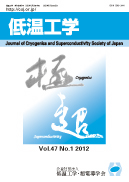All issues

Volume 47, Issue 9
Displaying 1-5 of 5 articles from this issue
- |<
- <
- 1
- >
- >|
Preface
-
[in Japanese]2012Volume 47Issue 9 Pages 553
Published: September 25, 2012
Released on J-STAGE: November 02, 2012
JOURNAL FREE ACCESSDownload PDF (617K)
Review Article
-
Seiichiro ARIYOSHI, Kensuke NAKAJIMA, Atsushi SAITO, Tohru TAINO, Chik ...2012Volume 47Issue 9 Pages 554-561
Published: September 25, 2012
Released on J-STAGE: November 02, 2012
JOURNAL FREE ACCESSWe propose a novel microwave kinetic inductance detector (MKID) named spiral-MKID typified by a rewound spiral strip structure suitable for terahertz applications. The superconducting rewound strip works as a high-Q half wavelength microwave resonator as well as a broadband terahertz antenna. The spiral-MKIDs fabricated with NbN films reveal loaded quality factors of the order of 104 at 3 K. NbN is one of the promising materials suitable for working on a convenient 4K-refrigerator. We also discuss the expected noise equivalent power of the optimized detector.View full abstractDownload PDF (2036K)
Originals
-
Atsushi OBAYASHI, Shu-Han HSU, Tetsushi BIWA2012Volume 47Issue 9 Pages 562-567
Published: September 25, 2012
Released on J-STAGE: November 02, 2012
JOURNAL FREE ACCESSWe compare a regenerator comprised of stacked wire meshes with that made of a honeycomb ceramic catalyst by measuring the acoustic fields in a tube containing the regenerator and air working gas at atmospheric pressure. The flow resistance of the wire-mesh regenerator increases in proportion to the velocity amplitude, whereas that of the honeycomb regenerator remains constant. An empirical equation of the flow resistance is proposed for the wire-mesh regenerator using an acoustic Reynolds number and ωτν (ω is the angular frequency of the acoustic waves and τνis the viscous relaxation time given using effective pore radius). The difference between these regenerators is also observed in the increased acoustic power achieved in the presence of axial temperature differences.View full abstractDownload PDF (1263K) -
Nobutaka KAWASAKI, Shou UEHARA, Satoshi FUKUI, Jun OGAWA, Takao SATO, ...2012Volume 47Issue 9 Pages 568-575
Published: September 25, 2012
Released on J-STAGE: November 02, 2012
JOURNAL FREE ACCESSIntense magnetic fields exceeding 2 T are necessary to magnetize rare-earth magnets to extract the full performance of magnet materials. In this report, we deal with the experimental measurements and numerical analysis of the magnetic flux after scans of the 3 T HTS bulk magnet on the surface of the rare-earth magnet. The distributions of the magnetic flux density between measured and simulated data on the magnet slab showed good agreement after the scanning. The study is conducted to evaluate the magnetization performances of bulk magnets for the interior permanent magnet (IPM) motors. According to the numerical analysis, the magnetic field of 3 T reached the point of 22 mm from the surface of the rotor. The experimental data clarified that the magnet slab (26 × 20 × 5 mm3) in the rotor was fully magnetized by scanning the bulk magnet on it, while the neighboring magnet was barely magnetized in the rotor because of its anisotropic magnetizing property. This shows that the magnets in IPM motors are capable of being activated from outside the rotors with use of HTS bulk magnets, which suggests an improved degree of freedom in designing the motor.View full abstractDownload PDF (3011K) -
Hiroto KUSAKA, Mitsushi ABE, Takeshi NAKAYAMA, Manabu AOK I, Yoshiya H ...2012Volume 47Issue 9 Pages 576-582
Published: September 25, 2012
Released on J-STAGE: November 02, 2012
JOURNAL FREE ACCESSIn order to find the cause of quenching in superconducting magnets, it is important to identify the initial normal zone. We focus on the changing tendency of the voltage across the coil just after the normal transition increases with an increase in the magnetic flux density of the initial normal zone. We develop an estimation method for the initial normal zone of the coil crosssectional direction by searching for the result closest to the measured waveforms from among the results of the transient circuit analysis that assumed the initial normal zone. Functional approximation using a nonlinear least-squares method is used for the search. Applying this technique to the low-temperature superconducting magnet system, we could identify the initial normal zone. This evaluation result is consistent with the result obtained by the interlayer voltage measurement. Since there is no need to install multiple voltage terminals inside the coil, this technique is a non-invasive evaluation method.View full abstractDownload PDF (1105K)
- |<
- <
- 1
- >
- >|